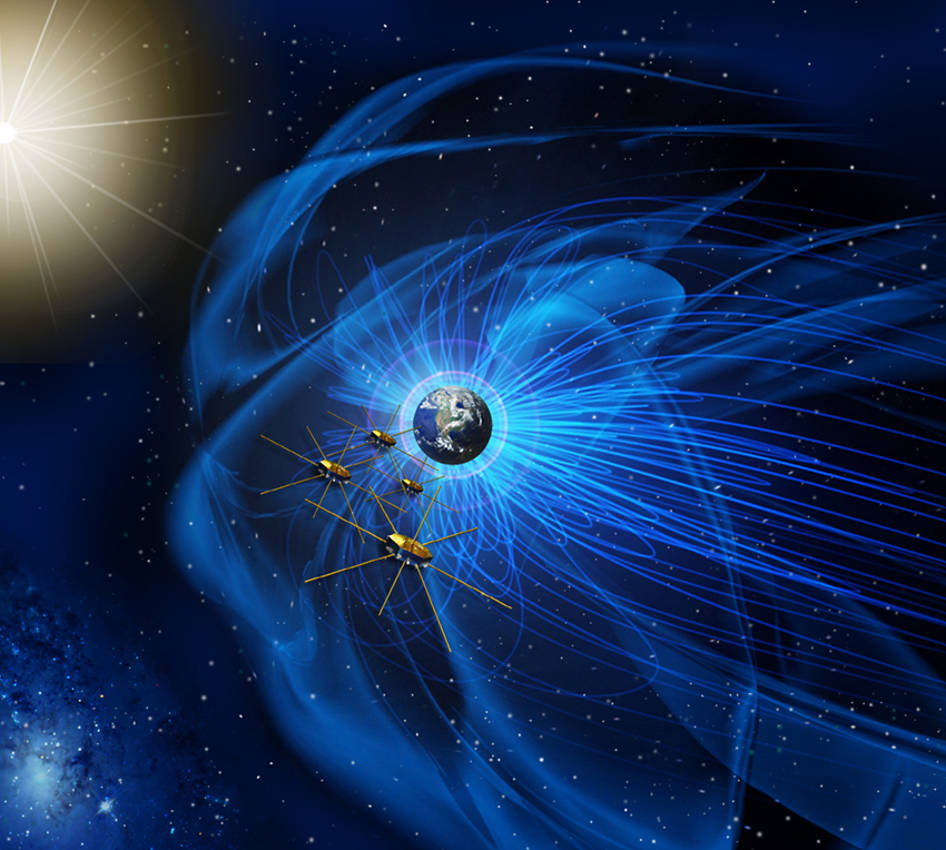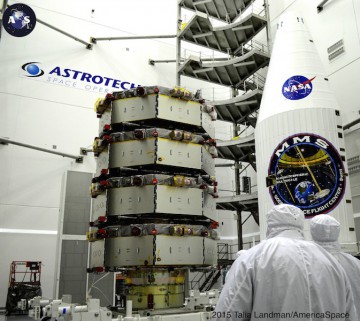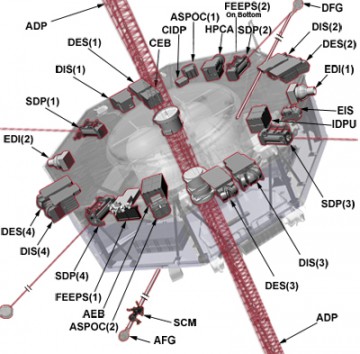
Another NASA mission is about to blast into the magnetosphere. Four solar-terrestrial satellites are set to launch this week atop a United Launch Alliance (ULA) Atlas-V rocket from Cape Canaveral Air Force Station Space Launch Complex-41 (SLC-41). The Magnetospheric Multiscale (MMS) Mission will explore the Sun’s and the Earth’s magnetic fields, and study how they connect and disconnect in a process that occurs naturally throughout the universe known as magnetic reconnection.
The four identically-instrumented observatories were built at NASA Goddard Space Flight Center in Greenbelt, Md., then transported and stacked at Astrotech Space Operations in Titusville, Fla. The spacecraft was then encapsulated and transported to SLC-41 during the early morning hours on Friday, Feb. 27. The launch is currently scheduled for Thursday, March 12, with the 30-minute window opening at 10:44 pm EDT.
Bookmark our MMS Launch Tracker for regular updates and live coverage on launch day!

The fleet of solar-terrestrial probes will orbit Earth’s magnetic system and travel through areas known to be magnetic reconnection sites. NASA describes magnetic reconnection as “a fundamental process that occurs throughout the universe when magnetic fields connect and disconnect explosively, releasing energy and accelerating particles up to nearly the speed of light.”
Magnetic reconnection begins with solar flares and coronal mass ejections on the Sun. The energy from these explosions interferes with Earth’s protective bubble, the magnetosphere, and causes disruptive space weather. When this happens it affects GPS signals, spacecraft electronics, and radio communications, and causes communications blackouts on Earth. On the flip side, magnetic reconnection can be very beautiful, producing an elegant light show in the northern and southern hemispheres known as the Aurora Borealis (north) and Aurora Australis (south).
This universal occurrence is unique to plasma, the mixture of positively and negatively charged particles that makes up nearly 99 percent of the known universe. MMS will use Earth’s magnetosphere as a laboratory to measure magnetic reconnection, energetic particle acceleration, and turbulence in these plasma processes.
MMS will give us a better understanding of how these processes work on the Sun, other stars, and into interstellar space. The mission will bring answers to these fundamental open questions:
- What determines when reconnection starts and how fast it proceeds?
- What is the structure of the diffusion region?
- How do the plasmas and magnetic fields disconnect and reconnect in the diffusion regions?
- What role do the electrons play in facilitating reconnection?
- What is the role of turbulence in the reconnection process?
- How does reconnection lead to the acceleration of particles to high energies?
Each MMS observatory carries 11 scientific experiments designed to measure the energy of charged particles, plasma, and electric and magnetic fields. Each MMS spacecraft is made up of 25 separate key sensors that are able to capture measurements 100 times faster than previous missions. MMS will fly through reconnection areas in less than a second and provide a 3-D view of this mysterious process taking place on the Sun, other planets, and everywhere in the Universe.
![MMS Four Separate – View of all four spacecraft in the MMS Cleanroom getting prepared for stacking operations. [Photo Credit NASA/Chris Gunn]](https://www.americaspace.com/wp-content/uploads/2015/03/mms_001_cg_lg.jpg)
“If you look up, you see these sets of pairs of instruments that have the curved red covers. There are actually four sets of those around there, so there ends up being 32 of those instruments. Those are one of our most important instruments. We had a very hard time with a very specific custom electronic part that’s essential to how this does the science. We actually worked for the last two years to both categorize and fix that problem. Another challenge was just the challenge of nearly simultaneously building four things with this many instruments. The logistics and the engineering of orchestrating, building, and testing these four was quite a challenge.”
The MMS instruments were made around the world by various partnering institutions. NASA divided the sensors into three groups:
- The Hot Plasma Suite makes observations on the nature of the charged gas, or plasma, present during reconnection. This group includes the Fast Plasma Investigation (FPI) instrument that observes fast-moving plasma, and the Hot Plasma Composition Analyzer (HPCA) detects which kinds of ions are present.
- The Energetic Particles Detector Suite (EPDS) observes fast-moving, energetic particles and remotely senses the structure of the larger space environment surrounding the regions where magnetic reconnection is occurs. It includes the Fly’s Eye Energetic Particle Sensor (FEEPS) that works “to obtain nearly instantaneous all-sky measurements of how many electrons of different energies and different arrival directions are present.” The Energetic Ion Spectrometer (EIS) is also included in this group of instruments. EIS also gathers all-sky measurements of the energetic ions, gathering information about their energy, their arrival direction and their mass.

Each MMS observatory carries 11 scientific experiments designed to measure the energy of charged particles, plasma, and electric and magnetic fields. Each MMS spacecraft is made up of 25 separate key sensors that are able to capture measurements 100 times faster than previous missions - The Fields Suite observes the magnetic fields themselves, as well as the signatures of electric fields that change their configuration as part of the reconnection process. The Fields Suite is composed of six sensors. The Analog Fluxgate (AFG) and Digital Fluxgate (DFG) Magnetometers “carry a permeable material that changes properties in response to the presence of magnetic fields.” By tracking the path of electron beams through space, the Electron Drift Instrument (EDI) measures both the electric and magnetic fields. The Spin-plane Double Probe (SDP) and the Axial Double Probe (ADP) “measures the voltage between two electrodes to determine the electric field.” The Search Coil Magnetometer (SCM) “provides direct measurements of changes in the magnetic fields, using something called an induction magnetometer.” The FIELDS Central Electronics (CEB) coordinates, collects, and transmits the measurements from this central electronic system.
In addition to the basic MMS instruments, the payload includes instrument controls. The Two Active Spacecraft Potential Control Devices (ASPOC) function to “neutralize the electrical potential of the spacecraft, limiting or eliminating spurious electric fields that can contaminate measurements.” The Central Instrument Data Processor (CIDP) “provides the interface between the instruments and the spacecraft Command and Data Handling subsystem.”
More than 400 people at Goddard contributed to the testing and building of MMS, as well as a few hundred more from various institutions. The orbits for MMS are designed to study two regions of magnetic reconnection that occur near the boundaries of the Earth’s magnetosphere. The first year and a half of the mission will focus on the magnetosphere’s dayside boundary with the Sun. For the last six months of the mission, MMS will focus on the night side of Earth in our planet’s magnetic tail. MMS personnel will track and command the two-year science mission from a control center at NASA Goddard.
Want to keep up-to-date with all things space? Be sure to “Like” AmericaSpace on Facebook and follow us on Twitter: @AmericaSpace
Missions » MMS »


